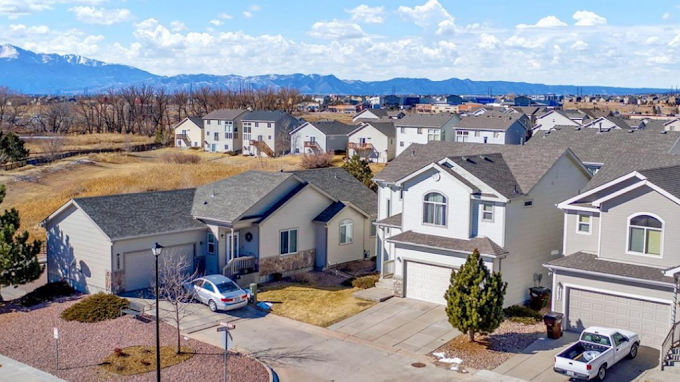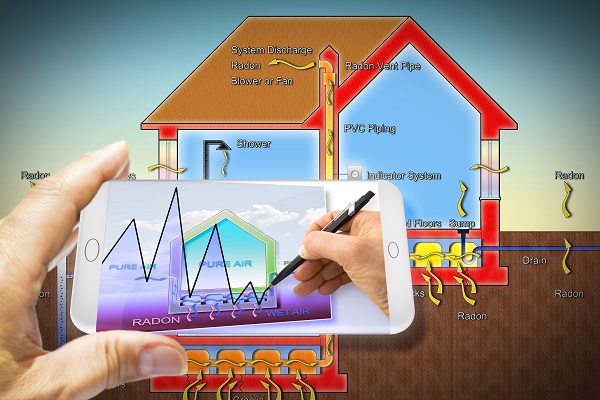Colorado Springs is a booming housing market, attracting new residents with its stunning mountain views, strong job market, and quality of life. As neighborhoods expand across El Paso County, one important but often overlooked question arises: are new homes in Colorado Springs being built with radon mitigation systems in place?
Radon is a naturally occurring radioactive gas that can enter homes through the soil. It is odorless, colorless, and tasteless, making it impossible to detect without proper testing. Long-term exposure to elevated radon levels is the second leading cause of lung cancer in the United States, according to the Environmental Protection Agency (EPA). With Colorado being one of the states with the highest potential for radon, understanding how builders are addressing this issue in new construction is critical for homebuyers, real estate professionals, and public health advocates.
In this post, we’ll explore the radon risks specific to Colorado Springs, the current state and local building code requirements, how builders are responding to radon concerns, and what new homebuyers should know before moving in. We’ll also discuss the long-term value of active radon mitigation systems and how companies like Advanced Radon Systems help protect homes across the region.
Understanding Radon in Colorado Springs
Radon gas forms from the natural breakdown of uranium in soil, rock, and water. It seeps into homes through foundation cracks, sump pumps, crawlspaces, construction joints, and other openings. Once inside, radon can accumulate to dangerous levels, especially in homes with tight building envelopes and limited ventilation.
El Paso County, including Colorado Springs, is classified by the EPA as a Zone 1 area, which means it has the highest potential for elevated radon levels. In fact, state surveys estimate that roughly 50% of homes in Colorado test above the EPA action level of 4.0 picocuries per liter (pCi/L). Some homes test significantly higher.
Given the geology of the Front Range and the popularity of basements in Colorado homes, local properties are particularly vulnerable to radon exposure. It is not a question of if radon is present, but how much is present and whether a system is in place to control it.
Why New Construction Is Not Automatically Safe
There is a common misconception that new homes are immune to radon. Many buyers assume that newer construction means better safety, better ventilation, and up-to-date systems that would naturally include radon mitigation. Unfortunately, that is not always the case.
While newer homes may have tighter seals, modern insulation, and improved energy efficiency, those same qualities can actually trap radon gas inside. Without passive or active radon mitigation systems, a new home can still have high radon levels, sometimes higher than older homes with more airflow.
This misconception is one reason why awareness and education around radon in new construction remain so important.
What Do Colorado Building Codes Require?
Colorado currently does not have a statewide law that mandates radon mitigation systems in all new homes. However, some local jurisdictions have adopted specific requirements. The city of Colorado Springs and El Paso County both follow the International Residential Code (IRC) with local amendments. The IRC includes provisions for radon-resistant construction, but adoption of these provisions varies.
As of 2025, El Paso County has adopted the 2015 International Residential Code, which includes Appendix F, a section that provides guidelines for radon-resistant new construction (RRNC). However, the appendix is not automatically enforced unless the local authority specifically adopts it.
So, is Appendix F enforced in Colorado Springs?
Yes—in certain developments and under certain conditions. The City of Colorado Springs has adopted Appendix F of the IRC and requires RRNC measures in areas where radon testing has shown high potential. That means builders in designated areas must install a passive radon system at minimum. These systems include a sub-slab depressurization pipe routed from beneath the foundation through the home and vented through the roof. However, a passive system is not powered by a fan and may not be enough to reduce radon to safe levels in some homes.
Many homeowners ultimately need to convert the passive system into an active system by adding a radon fan and monitoring device. Active systems provide continuous, reliable protection and are the gold standard for mitigation.
Enforcement Gaps Still Exist
Not every home in El Paso County is subject to the same level of enforcement. Suburban areas, custom home builds, or homes outside city limits may fall into regulatory gaps. Additionally, not all builders proactively include mitigation systems if they are not required to do so by code.
This inconsistency makes it important for buyers to ask the right questions and perform post-construction testing regardless of when the home was built.
Are Local Builders Including Radon Systems?
The answer is: some are, but not all.
Major production builders like Classic Homes, Challenger Homes, and Vantage Homes build many of the new subdivisions in and around Colorado Springs. Some of these companies do include passive radon systems in compliance with Appendix F. A few offer upgrades to active systems or at least pre-wiring to allow for future activation.
However, not every builder includes radon mitigation by default. And in the case of custom or semi-custom homes, the decision may rest solely on the homeowner or general contractor. The level of inclusion depends on the builder’s policy, the neighborhood’s location, and whether the home falls within a mandatory compliance zone.
It’s worth noting that many builders include other optional upgrades like solar panels, gourmet kitchens, and finished basements, but radon mitigation often remains an optional or overlooked feature.
The Rise of Radon Awareness Among Buyers
Fortunately, more buyers are beginning to recognize the importance of radon testing and mitigation—especially those relocating from out of state or purchasing higher-end properties. Home inspectors and real estate agents are also more frequently recommending radon testing as part of the due diligence process, even for brand-new homes.
Buyers are starting to ask questions like:
-
Is there a passive or active radon system in this home?
-
Was the soil tested for radon before construction?
-
Is there a radon test result available for the finished home?
-
Can the builder add an active radon fan before closing?
-
How much would it cost to upgrade the system post-sale?
These questions reflect a growing trend toward environmental health awareness, especially among young families and retirees who make up a large portion of Colorado Springs’ real estate market.
Passive vs. Active Radon Systems: What’s the Difference?
Understanding the two main types of radon mitigation systems can help buyers make informed decisions.
Passive Radon Systems
A passive system includes a vertical pipe that runs from below the home’s slab to the roof. It allows radon gas to rise naturally through the pipe and exit above the roofline. While it helps reduce radon levels, a passive system relies entirely on natural air movement and may not provide adequate reduction in high-radon areas.
Pros:
-
Often required by building codes
-
Quiet and energy efficient
-
No electrical components
Cons:
-
Less effective than active systems
-
No built-in fan or monitoring
-
May not reduce radon below 4.0 pCi/L
Active Radon Systems
An active radon mitigation system includes all the elements of a passive system but with an added fan that continuously draws radon from beneath the home and expels it outside. It may also include a monitoring device or gauge to confirm the system is working.
Pros:
-
More effective at reducing radon levels
-
Continuous protection
-
Can be monitored and maintained
Cons:
-
Requires power
-
Fan will eventually need replacement (every 5 to 10 years)
-
Slightly higher upfront cost
For many Colorado Springs homes, especially those with basements, an active system is the most reliable choice for peace of mind.
Why Builders Should Include Radon Mitigation Systems
There are several reasons builders should proactively install radon mitigation systems during construction:
-
Health and Safety: Protecting families from a known carcinogen adds tremendous value to the home and supports public health.
-
Cost Efficiency: Installing a system during construction is significantly less expensive than retrofitting one later. Slab penetration, piping, and routing are all simpler before the walls are finished.
-
Market Differentiation: Builders who include active radon systems can promote their homes as healthier and more environmentally conscious.
-
Futureproofing: As awareness and regulations increase, radon mitigation will become more expected. Builders who get ahead of the curve are positioned to stand out.
What Homebuyers Can Do
If you are buying a new home in Colorado Springs, you have the power to advocate for your safety. Here are some proactive steps you can take:
-
Ask About the Radon System
Don’t assume your new home includes radon protection. Ask your builder or agent for details on whether a system is installed, and whether it is passive or active. -
Request a Radon Test
Even if the home is new, you can and should request a professional radon test before closing. Builders may allow testing during the final walkthrough or shortly after move-in. -
Negotiate System Upgrades
If a passive system is installed, ask the builder to convert it to an active system as part of the purchase. It’s a relatively simple upgrade and may be more cost-effective to do before you take ownership. -
Work with a Local Radon Specialist
Companies like Advanced Radon Systems can test radon levels in new homes and upgrade existing systems as needed. Working with a certified radon mitigation professional ensures the job is done right. -
Don’t Forget Long-Term Maintenance
If your home has an active system, keep an eye on the fan, monitoring gauge, and any noise or airflow changes. Periodic checks and filter replacements keep the system running efficiently.
Advanced Radon Systems: Your Local Partner in New Construction Safety
Advanced Radon Systems has served Colorado Springs and surrounding areas for years, helping homeowners, builders, and real estate professionals create safer indoor environments. Our team specializes in radon testing, system design, and custom mitigation solutions for both new and existing homes.
We work directly with builders and homeowners to:
-
Install active radon systems during construction
-
Convert passive systems into active ones
-
Conduct accurate post-construction testing
-
Educate clients on radon risk and long-term safety
-
Ensure compliance with local codes and best practices
Whether you’re building a custom home, buying a brand-new property, or just want peace of mind, our experts can guide you through every step.
Final Thoughts
The rapid pace of development in Colorado Springs has brought modern amenities and beautiful new neighborhoods, but it has also raised important questions about health and safety. Radon is an invisible risk that should not be ignored, especially in a high-risk zone like El Paso County.
While local building codes have taken steps to address radon in new construction, enforcement remains inconsistent, and not every builder goes the extra mile. As a result, it is up to homebuyers to ask the right questions, request radon testing, and invest in systems that protect their families.
By including radon mitigation as part of the new home conversation, buyers can make smarter decisions, builders can add lasting value, and our community can stay safer together.
For professional radon testing and mitigation in Colorado Springs, contact Advanced Radon Systems today. Our experienced team is here to help you build and live safer.




